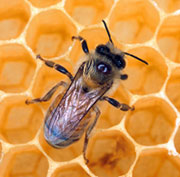
| The Silence of the Buzzing | 5 May 10 |
 Bees contribute an estimated $15 billion dollars per year to the U.S. economy. But for the fourth year in a row American apiaries have been ravaged by the phenomenon dubbed colony collapse disorder (CCD). The number of managed colonies fell by 33.8% according to a survey by the Apiary Inspectors of America and the US Agricultural Research Service (ARS). Bees contribute an estimated $15 billion dollars per year to the U.S. economy. But for the fourth year in a row American apiaries have been ravaged by the phenomenon dubbed colony collapse disorder (CCD). The number of managed colonies fell by 33.8% according to a survey by the Apiary Inspectors of America and the US Agricultural Research Service (ARS).No one is precisely certain of the cause of CCD. A January 2010 Congressional Report, entitled "Honey Bee Colony Collapse Disorder" identified three major possibilities: pesticides, parasites, and a combination of existing stresses that may compromise the immune system of bees and disrupt their social system. Many environmental groups and publications have honed in on the risks posed by pesticides, and in particular a class of pesticides known as neonicotinoids. One such pesticide, clothianidin, is "highly toxic to honey bees" according to an Environmental Protection Agency (EPA) Fact Sheet and has already been banned in several European countries. The Natural Resources Defense Council (NRDC) and the Xerces Society successfully sued to invalidate EPA approval of the pesticide spirotetramat, a related neonicotinoid pesticide, in December of 2009, but other neonicotinoids like clothianidin remain on the shelves. View May 2, 2010 Observer articleView January 7, 2010 Congressional Report (PDF) View January 7, 2010 Earth 360 article View October/November 2009 Mother Earth News article View December 29, 2009 NRDC press release View more information on Manitoba Wildlands Source: The Observer, Congressional Research Service, NRDC |
|
 Print version Print version |
Top |
